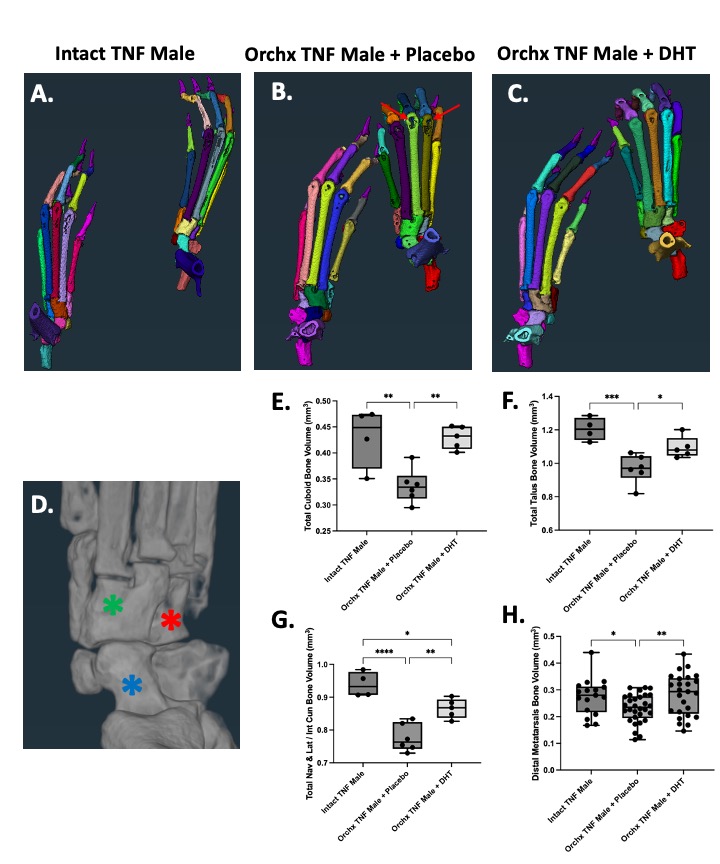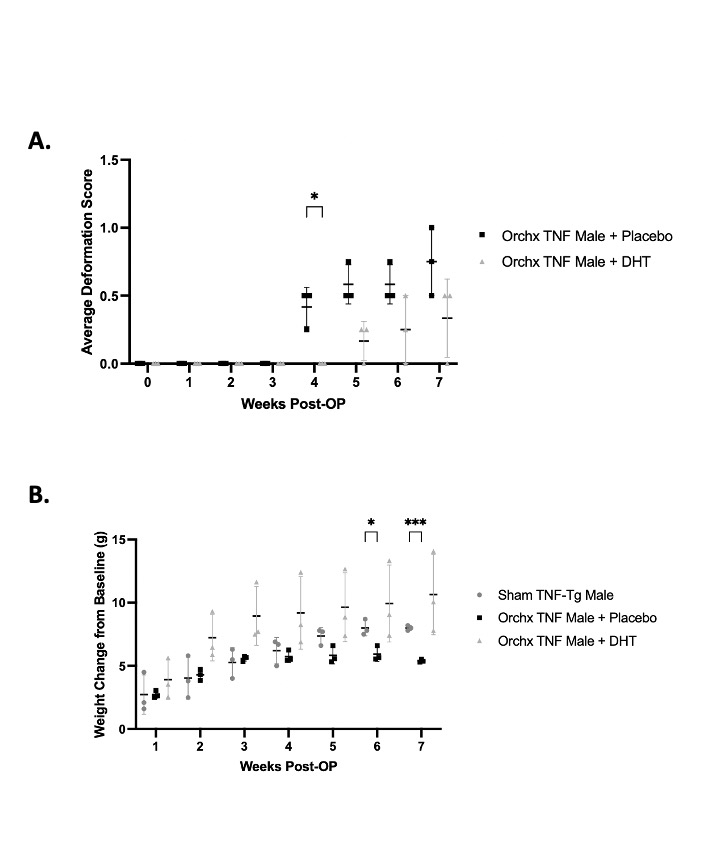Session Information
Session Type: Poster Session C
Session Time: 9:00AM-11:00AM
Background/Purpose: Rheumatoid arthritis (RA) is characterized by chronic joint inflammation and bone erosion and is female predominant. The TNF-transgenic (TNF-Tg) murine model of RA develops inflammatory erosive arthritis and displays a sex difference in disease severity, with females having worse disease than males (1). Studies suggest androgens provide a protective effect against joint disease and TNF-mediated bone erosion (2). We have previously shown that the removal of endogenous sex hormones in TNF-Tg males significantly worsens their inflammatory erosive disease. Here, we investigated whether treatment of TNF-Tg mice with exogenous androgen ameliorates erosive disease.
Methods: TNF-Tg male mice were orchiectomized followed by subcutaneous implantation of either 5ɑ-dihydrotestosterone (DHT) or placebo pellet at 1-month old (n = 3/group). Pellets released 1.5mg of DHT or placebo for 60 days (0.025mg/day). Micro-computed tomography (µCT) scans of hindpaws were taken at 3-months old and compared with µCT data of same age intact TNF-Tg males (n = 4-6 paws/group). The total bone volumes (mm3) of the cuboid, talus, navicular and lateral intermediate cuneiform, and periarticular metatarsals were compared between groups. Deformation scores of the paws and weights were taken weekly from 1 to 3 months old. Same age sham TNF-Tg male mice weekly weights were compared between orchiectomized groups. Serum and paws were obtained for analysis and histology. Values are reported as the mean +/- standard deviation.
Results: Segmented hindpaw images showed bone erosion occurring in the periarticular regions of the metatarsals (Fig 1 A-C). Placebo-treated orchiectomized mice had significantly more bone volume loss than DHT-treated orchiectomized mice and intact mice in the cuboid (0.34 ± 0.03 Orchiectomized + Placebo; 0.43 ± 0.02 Orchiectomized + DHT; 0.43 ± 0.06 Intact), talus (0.97 ± 0.09 Orchiectomized + Placebo; 1.10 ±0.06 Orchiectomized + DHT; 1.21 ± 0.07 Intact), navicular and lateral intermediate cuneiform (0.78 ± 0.04 Orchiectomized + Placebo; 0.87 ± 0.03 Orchiectomized + DHT; 0.94 ± 0.04 Intact), and distal metatarsals (0.23 ± 0.05 Orchiectomized + Placebo; 0.28 ± 0.07 Orchiectomized + DHT; 0.27 ±0.07 Intact) (Fig 1D-H). Orchiectomized mice with placebo had significantly higher mean deformation scores at 4 weeks post-surgery (p = 0.03) (Fig 2A). Orchiectomized mice also gained significantly less weight than sham TNF-Tg mice by 6 weeks post-surgery (p = 0.03). DHT treatment of orchiectomized mice resolves that weight loss over time (Fig 2B).
Conclusion: Androgen treated orchiectomized arthritic mice had significantly improved bone volumes, limiting bone erosion even in the presence of ongoing inflammation. Clinical measures of weight loss and arthritis also improve with androgen treatment. These finding suggests sex hormones have a relationship with the immune system in inflammatory-erosive disease that warrants further study. Histological analysis of the paws and osteoclastogenic cultures of bone marrow are ongoing to delineate the mechanism of androgen effects on inflammation.
1. Bell R.D. et al. Arthritis Rheumatol 71(9): 1512-1523. 2019. 2. Traish A et al. J Clin Med 7(12): 549. 2018.
To cite this abstract in AMA style:
Chen K, Weidner A, Astapova O, Schwarz E, Rahimi H. Androgen Treatment Exhibits a Protective Role Against Focal Erosions in TNF-Induced Inflammatory Arthritis in Mice [abstract]. Arthritis Rheumatol. 2023; 75 (suppl 9). https://acrabstracts.org/abstract/androgen-treatment-exhibits-a-protective-role-against-focal-erosions-in-tnf-induced-inflammatory-arthritis-in-mice/. Accessed .« Back to ACR Convergence 2023
ACR Meeting Abstracts - https://acrabstracts.org/abstract/androgen-treatment-exhibits-a-protective-role-against-focal-erosions-in-tnf-induced-inflammatory-arthritis-in-mice/


